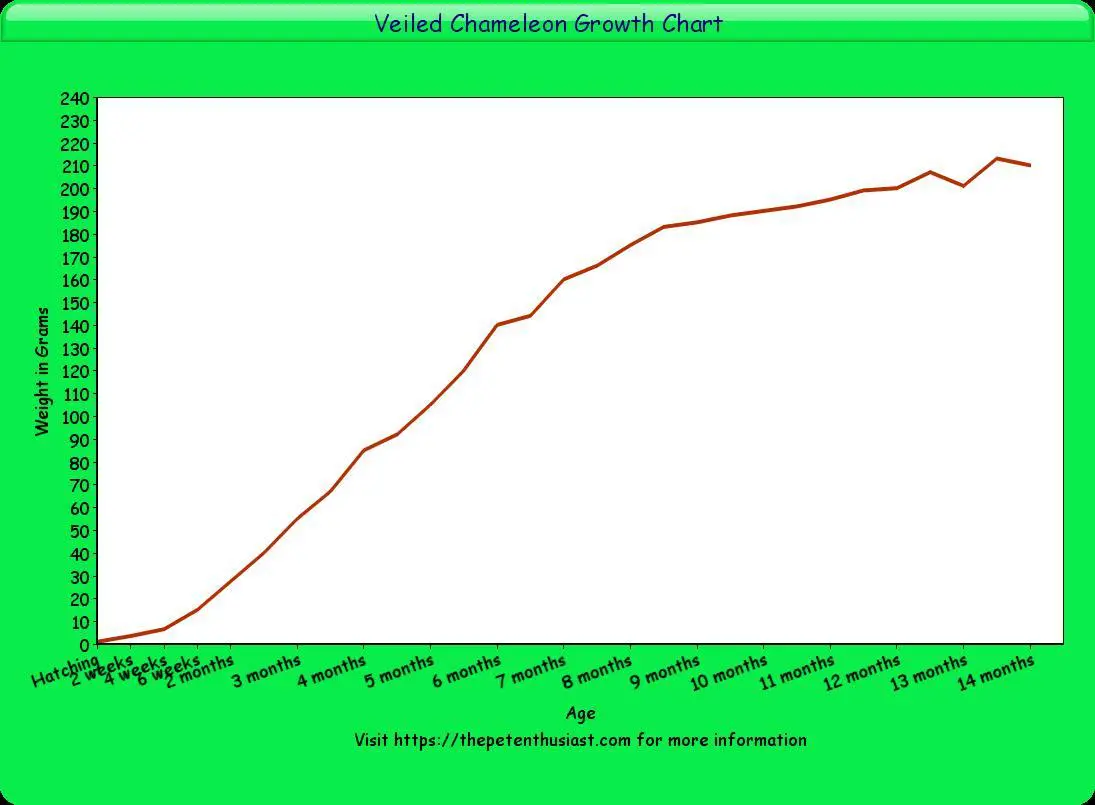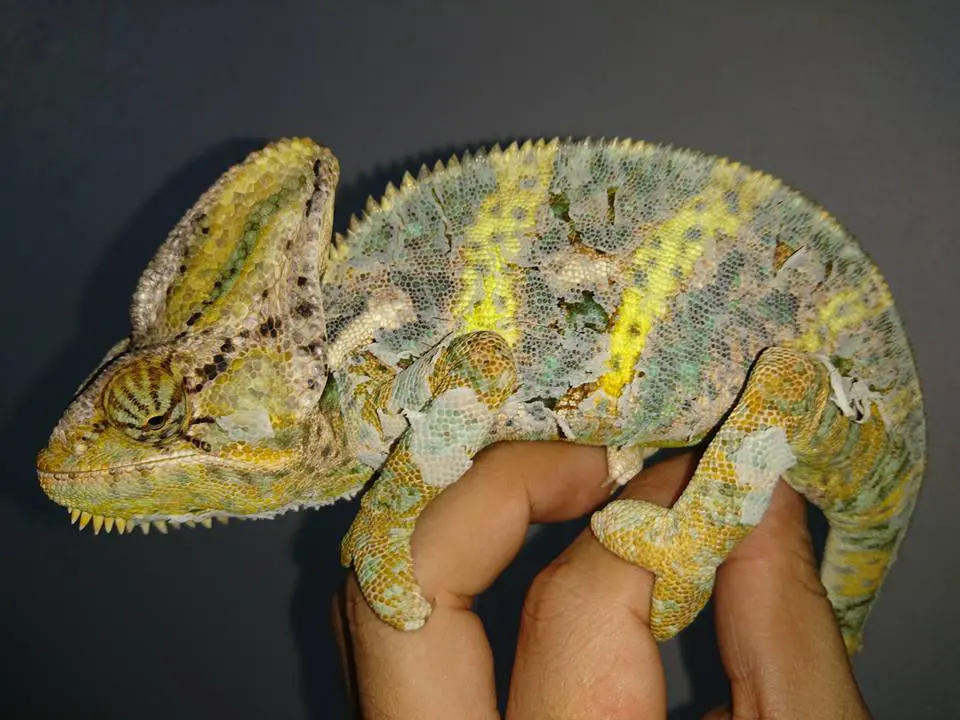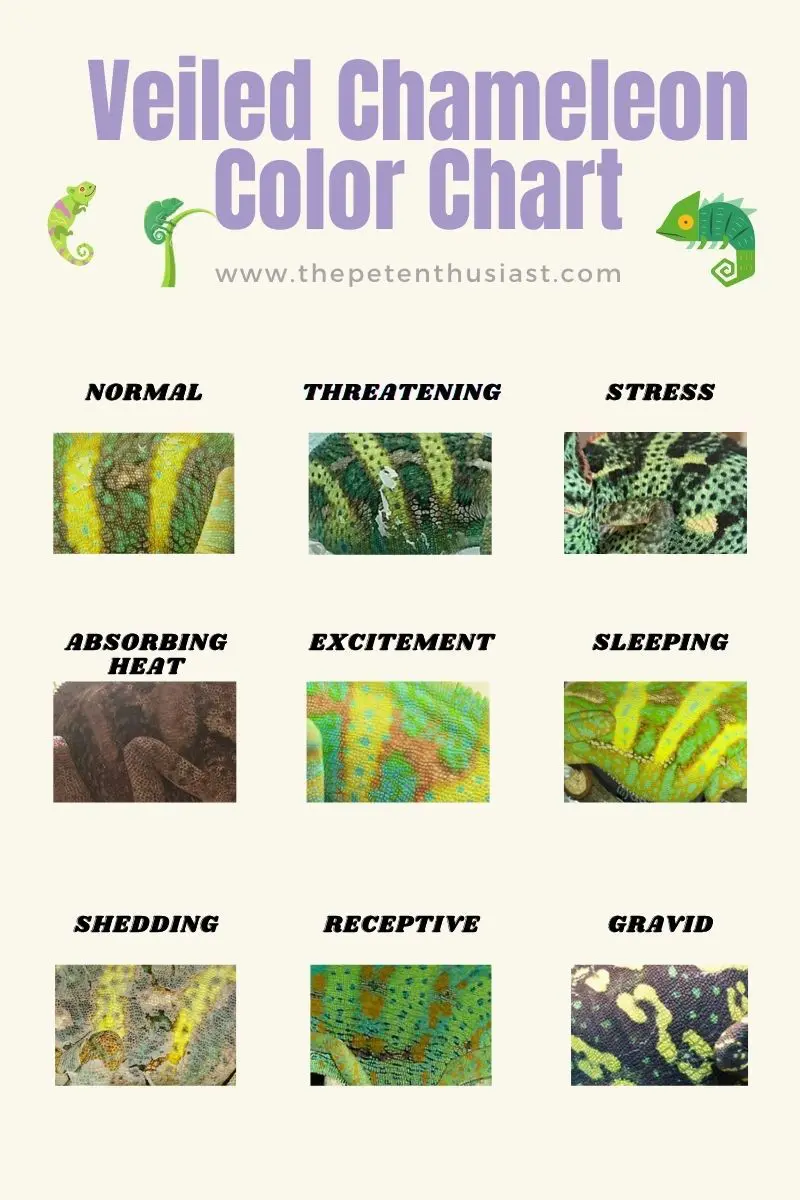Veiled chameleons are striking looking reptiles that are hardy and colorful. Their bodies have bands of yellows, greens, and browns, which adjust in varying shades.
These reptiles can live up to eight years in captivity with females being smaller than the males.
If you are a new veiled chameleon owner and want to identify how old your reptilian pet is or you want to ensure it is growing at a healthy rate, then continue reading for detailed information on the growth chart of these interesting and colorful pets.
How To Measure A Veiled Chameleon Weight?
Measuring your chameleon is essential to ensure it is healthy and not losing weight. If your chameleon is a baby, then measuring the weight can ensure it is growing at the right rate.
In order to measure weight, you will need:
- A digital food scale
- Plant or branch in a pot
- Your chameleon
Turn on the food scale and place the plant or pot with a branch onto the scale.
If you can zero the scale or alternatively you can take the weight of the plant/pot before adding your chameleon to get an accurate weight.
If your scale doesn’t turn to zero, simply deduct your start weight from the total weight to get a weight and age for your chameleon.
Veiled Chameleon Growth Chart
To get an idea on the weight of your veiled chameleon, below is a growth chart of one of my male chameleons.

|
Age | Weight |
|---|---|
|
Hatching | 1 gram |
|
2 weeks | 3 – 4 grams |
| 4 weeks |
5 – 8 grams |
| 6 weeks |
12 – 18 grams |
|
2 months | 20 – 35 grams |
| 3 months |
40 – 70 grams |
|
4 months | 80 – 90 grams |
| 5 months |
90 – 120 grams |
|
6 months | 130 – 150 grams |
| 7 months |
150 – 170 grams |
|
8 months | 170 – 180 grams |
| 9 months |
180 – 190 grams |
|
10 – 24 months |
190 – 250 grams |
When is a veiled chameleon a baby?
A veiled chameleon is considered a baby from hatching up to six weeks.
When is a veiled chameleon a juvenile?
Your veiled chameleon is a juvenile from six weeks to eight months of age.
When is a veiled chameleon fully grown?
A veiled chameleon is fully grown when it reaches two years of age.
Do males and females grow differently?
Males develop faster than females, as they are larger when at the same age. Males develop a larger crest.
How long does it take for a veiled chameleon to grow?
It will take your veiled chameleon around two years to reach its full weight.
When do they grow fast?
Veiled chameleons grow the fastest from hatching to four months of age where they grow from one gram to approximately ninety grams.
When do they stop growing?
Your veiled chameleon should stop growing by two years of age.
Average weight of a full-grown veiled chameleon
The size of your veiled chameleon as an adult will be determined by whether it is male or female.
Males tend to grow up to 24 inches (61 centimeters) from the snout to the end of the tail, while females will grow up to 14 inches (33 centimeters) in length.
They are not heavy-bodied reptiles and males will usually reach around 190 grams fully grown, with females weighing in around one 118 grams at full adult weight.
When is a veiled chameleon considered underweight?
In order to identify if your veiled chameleon is underweight, you will want to look at its back, focusing on the bone ridge on the back.
An underweight chameleon will look very skinny near the ridge on the back. Ensure your chameleon is calm when checking, as they tend to flatten themselves if stressed or threatened, which can make even the healthiest chameleon look underweight.
Take note of the belly and how much fat is on the belly. The belly should be rounded when your chameleon is calm. There should not be a straight line from the back legs to the front legs. If your veiled chameleon is underweight, it will have thin legs, head, and tail.
When is a veiled chameleon considered overweight?
Female veiled chameleons need to be kept lean, as they will eat anything and have a tendency to get overweight easily to mature and mate.
When a female chameleon overeats, she can get too much fuel, resulting in large-sized egg clusters, which can make it hard for her to lay her eggs.
If your chameleon is overeating, then it will store fat in certain areas of the body, such as the body cavity and internal fat pads. You will see a softer appearance in these areas.
In order to help your chameleon lose some additional weight, simply cut back on their diet to a recommended amount. You can skip a feeding here and there if your pet is drastically overweight.
If you have a female chameleon who is overweight and having issues laying her eggs, you will need veterinary intervention to help extract the eggs.
Veiled Chameleon Development Stages
When do they start first shedding?

Your baby chameleon should shed within a few days of hatching and then they will continue shedding to accommodate their fast growth until they are around eighteen months. So, your chameleon should be shedding every three to four weeks.
When are they able to change colors?
Your veiled chameleon should start changing colors from around the age of five months.
Their adult coloration and ability to change colors will occur around this age with colors of greens, blue-greens, black, and even turquoise being seen.
They will change colors based on communication, temperature, and camouflage.

Related – Veiled chameleon color chart and meanings.
When can I tell if a veiled chameleon is a male or female?
When your veiled chameleon reaches five months, you should be able to tell if it is male or female. Even though they can breed at this age, they are not yet fully grown at this age.
When are they ready for mating/breeding?
Veiled chameleons can develop eggs from four to six months. It is recommended that you wait until your female is at least one year of age before you breed her.
At this age, she is mature and can focus on calcium stores to her eggs, rather than taking the calcium from her bones.
Factors That Impact Veiled Chameleon Growth Rate
Temperature
Veiled chameleons have very strict temperature requirements which are important to help them gain weight and grow.
Their ambient temperature should range between 72ºF and 80ºF. Basking areas should range between 85ºF and 92ºF.
When the temperatures are too low, your chameleon will grow at a slower rate. Heat directly impacts their appetite.
Use a digital thermometer for easy monitoring and ensuring optimum temperatures within the enclosure at all times.
Feeding Schedule
In order for your veiled chameleon to grow at a good rate, you need to not only stick to a feeding schedule but provide quality food. These chameleons are not fussy eaters and will eat just about anything they can catch.
The following foods are quality foods to feed to your veiled chameleon:
- Crickets are easily accessible.
- Silkworms can be used for hydration and are high in protein
- Superworms are inexpensive and easy to gut load
- Hornworms contain water for hydration but are not high in protein
- Dubia roaches are excellent but tend to hide. Place in a bowl for feeding.
Gut loading is useful to ensure that your chameleon gets the calcium, vitamins, and proteins it needs. Some important feeding times include:
- Allow your reptile to eat as much as they want within fifteen minutes
- Hatchlings and juveniles should be fed twice daily
- Adults can be fed every second day
- Add some vegetables as chameleons are omnivorous
- Juveniles and babies may not be keen on veggies, don’t stress too much
- Ensure you hydrate your chameleon to help absorb essential nutrients from their food source.